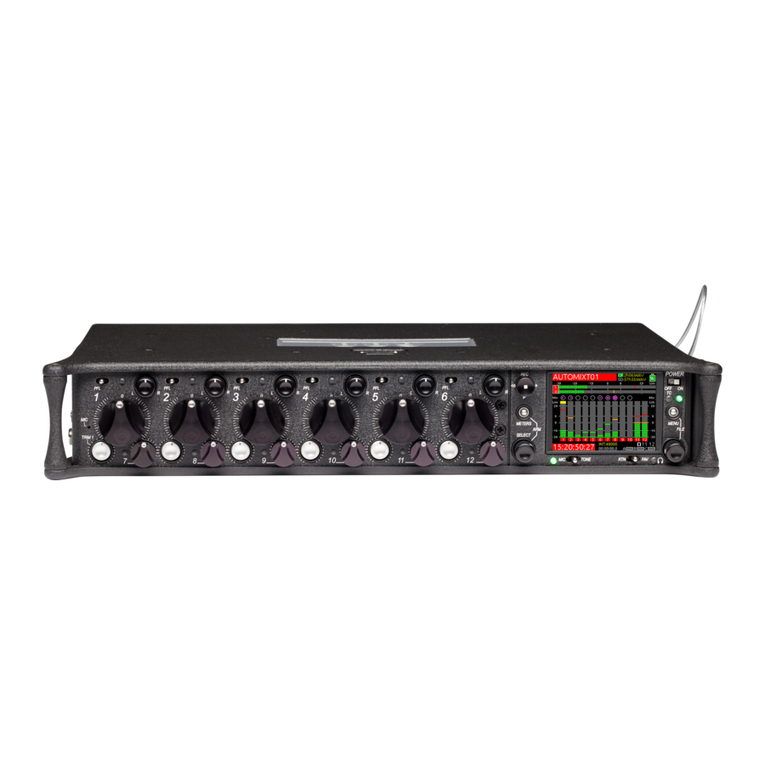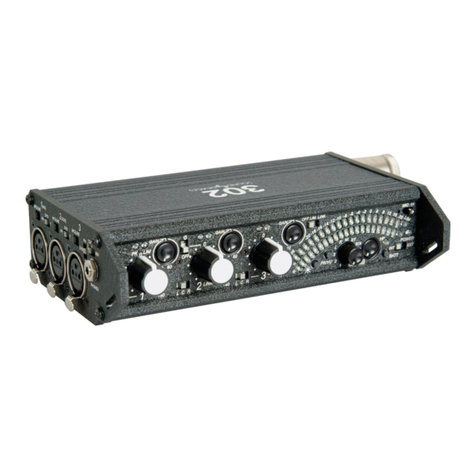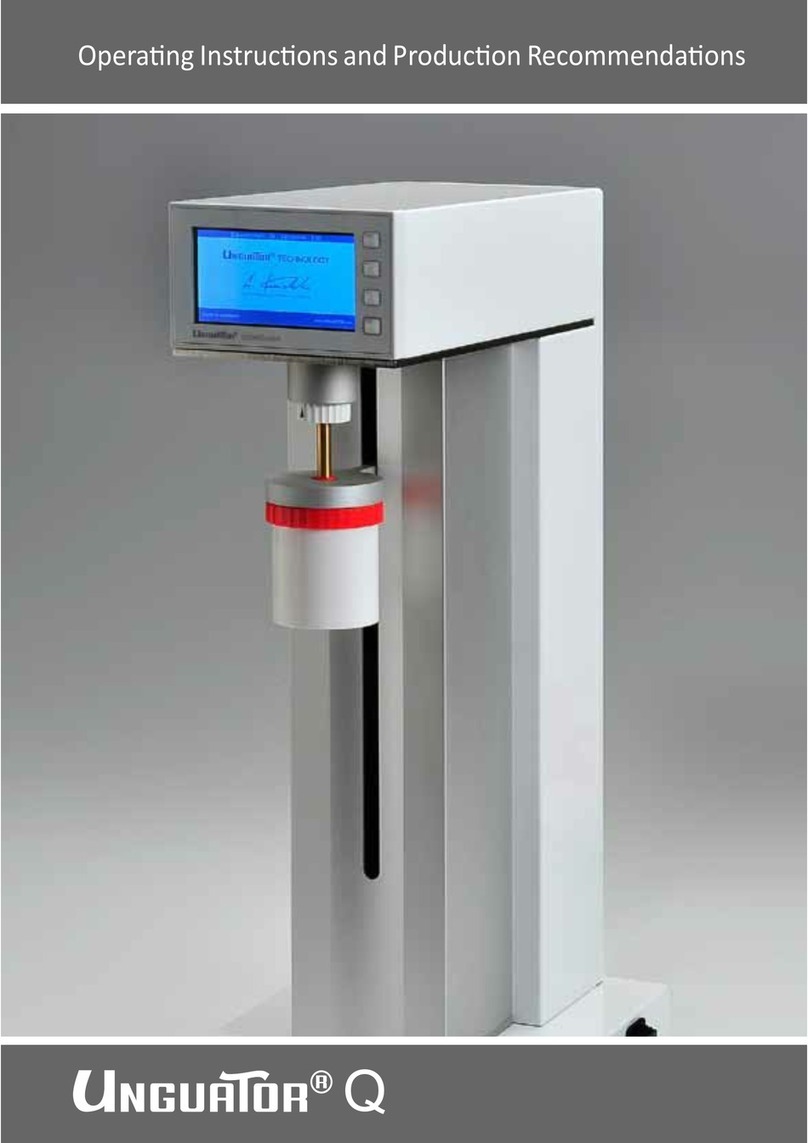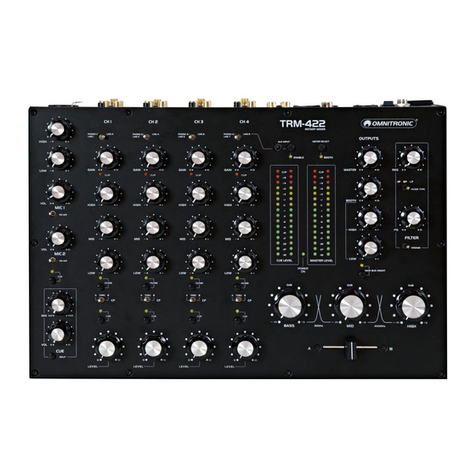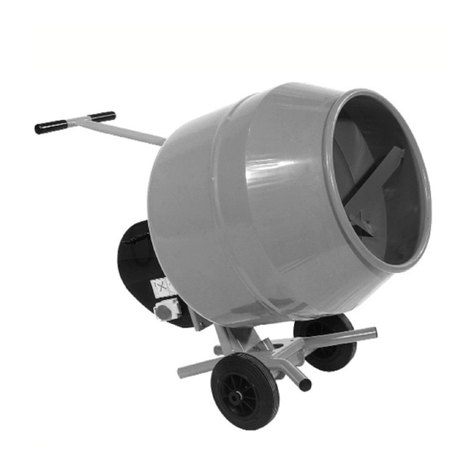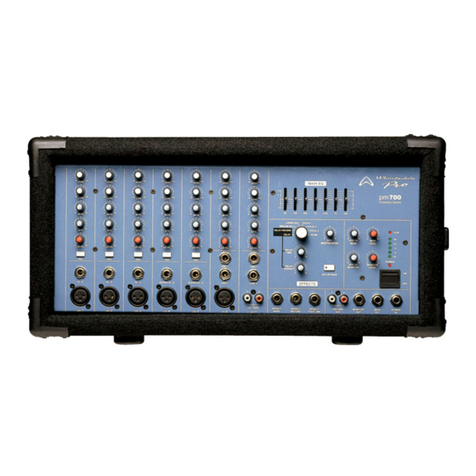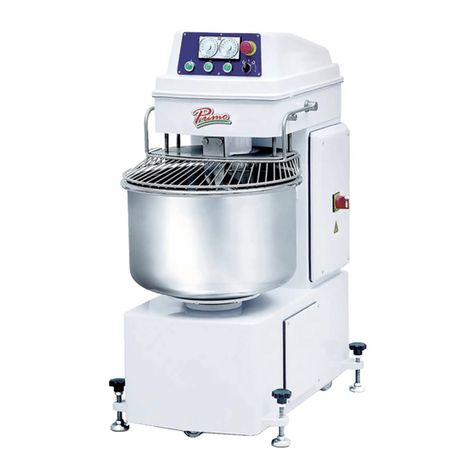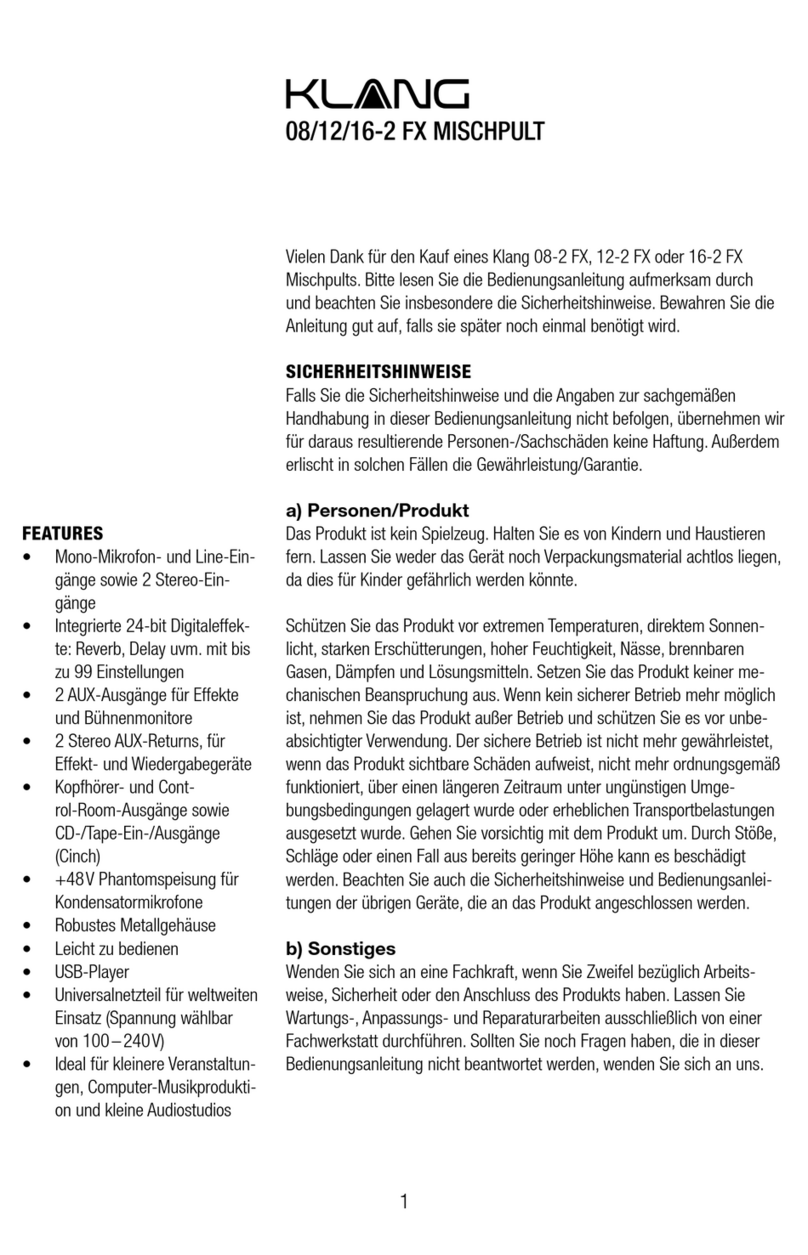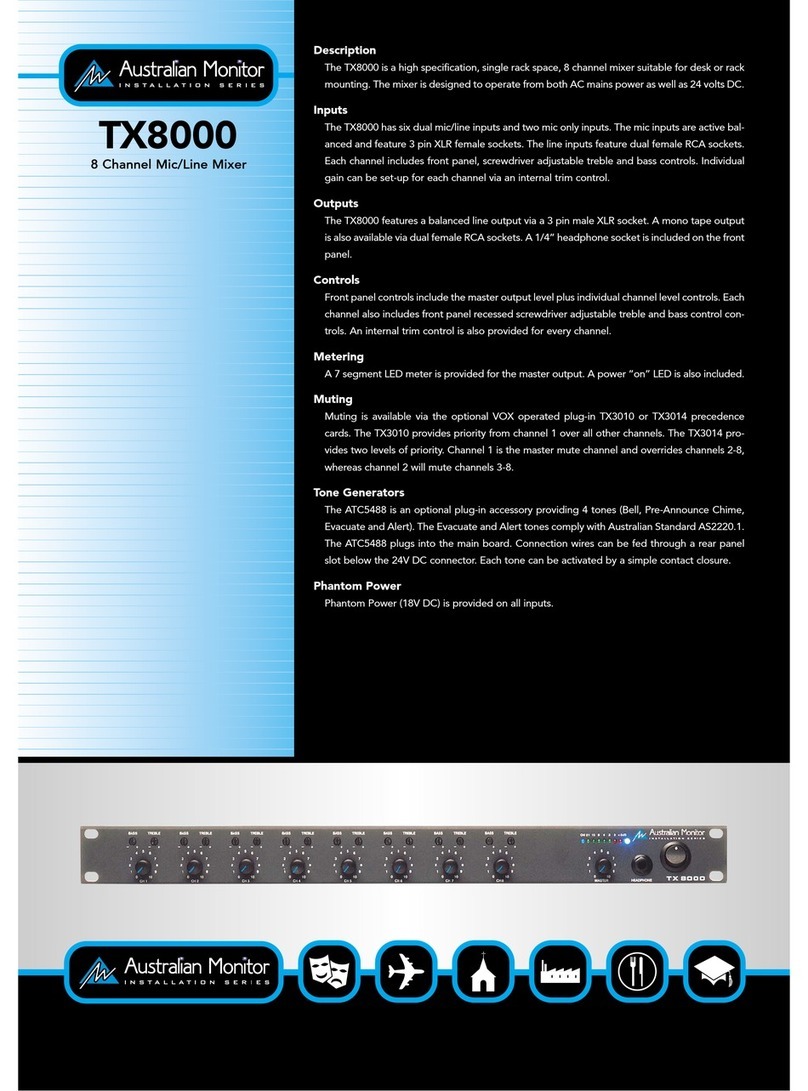Sound Devices 442 Manual

©2003–2009 Sound Devices, LLC
Sound Devices, LLC
300 Wengel Drive
Reedsburg, WI 53959 USA
Voice +1 (608) 524-0625
Fax +1 (608) 524-0655
www.sounddevices.com
442
Field Mixer
User Guide and Technical Information
for 442 and 442 Nordic Field Mixers

backside - front cover

1
Table of Contents
Quick Start Guide . . . . . . . . . . . . . . . . . . . . . . . .3
Powering . . . . . . . . . . . . . . . . . . . . . . . . . . . . . . . . . . 3
Input Channel Setup . . . . . . . . . . . . . . . . . . . . . . . . . 3
Output Connection . . . . . . . . . . . . . . . . . . . . . . . . . . 3
Headphone Monitoring . . . . . . . . . . . . . . . . . . . . . . . 3
Metering . . . . . . . . . . . . . . . . . . . . . . . . . . . . . . . . . . . 3
Limiting. . . . . . . . . . . . . . . . . . . . . . . . . . . . . . . . . . . . 3
Front Panel Descriptions . . . . . . . . . . . . . . . . . . 4
Input Panel Descriptions . . . . . . . . . . . . . . . . . . 6
Output Panel Descriptions . . . . . . . . . . . . . . . . .7
Input Channels . . . . . . . . . . . . . . . . . . . . . . . . . .8
Mic/Line Level Selection . . . . . . . . . . . . . . . . . . . . . . 8
Gain (trim) . . . . . . . . . . . . . . . . . . . . . . . . . . . . . . . . . 8
Channel Fader . . . . . . . . . . . . . . . . . . . . . . . . . . . . . . 8
Phantom and T- Microphone Powering . . . . . . . . . . . 8
High-Pass Filters . . . . . . . . . . . . . . . . . . . . . . . . . . . . 9
Pan Controls . . . . . . . . . . . . . . . . . . . . . . . . . . . . . . . 10
Input Limiters . . . . . . . . . . . . . . . . . . . . . . . . . . . . . . 10
LIM LEDs . . . . . . . . . . . . . . . . . . . . . . . . . . . . . . . . . . 10
Peak LEDs . . . . . . . . . . . . . . . . . . . . . . . . . . . . . . . . 10
Polarity Reversal - Channel 2 . . . . . . . . . . . . . . . . . . 10
Stereo Linking ON - Channels 1 and 2 . . . . . . . . . . . 11
Stereo Link MS - Channels 1 and 2 . . . . . . . . . . . . . 11
PFL (Channel Solo Monitoring) . . . . . . . . . . . . . . . . . 11
Outputs. . . . . . . . . . . . . . . . . . . . . . . . . . . . . . . . . 11
Master Gain Control . . . . . . . . . . . . . . . . . . . . . . . . . 11
Master Outputs - XLR and Hirose Multi-Pin . . . . . . . 11
Secondary Balanced Outputs . . . . . . . . . . . . . . . . . . 12
Tape Outputs (Mix Output) . . . . . . . . . . . . . . . . . . . . 12
Mono Mic Output . . . . . . . . . . . . . . . . . . . . . . . . . . . . 12
Output Limiter . . . . . . . . . . . . . . . . . . . . . . . . . . .12
LINK vs ON . . . . . . . . . . . . . . . . . . . . . . . . . . . . . . . . 13
Mix Input (linking mixers) . . . . . . . . . . . . . . . . . .13
Metering . . . . . . . . . . . . . . . . . . . . . . . . . . . . . . . .14
Meter Ballistics. . . . . . . . . . . . . . . . . . . . . . . . . . . . . . 14
Ballistics Lock. . . . . . . . . . . . . . . . . . . . . . . . . . . . . . . 14
Headphone Peak LED . . . . . . . . . . . . . . . . . . . . . . . 15
Headphone Monitoring . . . . . . . . . . . . . . . . . . . .15
Headphone Source Selection . . . . . . . . . . . . . . . . . . 15
Headphone Gain . . . . . . . . . . . . . . . . . . . . . . . . . . . . 15
Return A and B . . . . . . . . . . . . . . . . . . . . . . . . . . . . . 15
Powering. . . . . . . . . . . . . . . . . . . . . . . . . . . . . . . . 16
Internal Powering . . . . . . . . . . . . . . . . . . . . . . . . . . . 16
External Powering . . . . . . . . . . . . . . . . . . . . . . . . . . . 16
Power Metering . . . . . . . . . . . . . . . . . . . . . . . . . . . . . 16
Power Consumption . . . . . . . . . . . . . . . . . . . . . . . . . 16
Tone Oscillator / Slate Microphone . . . . . . . . . .17
Tone Oscillator . . . . . . . . . . . . . . . . . . . . . . . . . . . . . 17
Slate Microphone . . . . . . . . . . . . . . . . . . . . . . . . . . . 17
Accessing the Setup Menu. . . . . . . . . . . . . . . . . 18
Enter the Setup Menu . . . . . . . . . . . . . . . . . . . . . . . . 18
User Default . . . . . . . . . . . . . . . . . . . . . . . . . . . . . . . 18
442 Nordic Information . . . . . . . . . . . . . . . . . . . . 19
Setup Menus . . . . . . . . . . . . . . . . . . . . . . . . . . . . . . . 19
Setup Menu Firmware v 5.07 . . . . . . . . . . . . . . .20
Setup Menu Firmware v 3 & 4. . . . . . . . . . . . . . .21
Setup Menu Firmware v 2, (442 only). . . . . . . . .22
Specifications . . . . . . . . . . . . . . . . . . . . . . . . . . .23
System . . . . . . . . . . . . . . . . . . . . . . . . . . . . . . . . . . . . 23
Block Diagram - Inputs and Outputs . . . . . . . . . 26
Block Diagram - Monitoring . . . . . . . . . . . . . . . . 27
Accessories . . . . . . . . . . . . . . . . . . . . . . . . . . . .28
CE Declaration of Conformity . . . . . . . . . . . . . . 29
Warranty and Technical Support . . . . . . . . . . . .30
FCC Statement . . . . . . . . . . . . . . . . . . . . . . . . . . 30

442/442N User Guide and Technical Information
2
v. 5.07 Features and specifications are subject to change. Visit www.sounddevices.com for the latest documentation.
Welcome
Developed with insight from the industry’s top audio engineers, the 442 Field Mixer encompasses
the audio performance, feature set, and mechanical construction demanded by those who rely
on audio gear for their livelihood. The 442 contains four high-performance microphone preamplifiers,
multiple outputs, and flexible monitoring. Its inputs and outputs, including direct outputs on each
channel, make the 442 at home in small “run-and-gun” applications as well as large, multiple input
productions.
The 442 incorporates a complete feature-set into a compact, functional design. With no hidden controls,
the 442's parameters are accessible from the three main surfaces. The highly efficient circuitry allows the
mixer to be powered by either four internal AA batteries or external 5-18 VDC.
The 442, like all Sound Devices professional audio products, is designed to withstand the physical
and environmental extremes inherent to field production. Its compact construction strikes the perfect
balance between performance, accessible controls, and durability.

3
Quick Start Guide
For those familiar with field mixers or mixing consoles, this "Quick Start Guide" highlights basic
functionality to begin operating the 442.
Powering
1. For internal powering, insert four AA batteries with the positive (+) side first into the battery
compartment.
For external powering, connect the external DC power (5–18 VDC) to the 442's DC connector.
2. Slide the power switch in the direction of the intended power source (INT or EXT).
3. Press the battery check button to view voltage levels.
Input Channel Setup
1. Connect a signal source (microphone or line level signal) to a channel's XLR input connector.
2. Select the input type to MIC or LINE level.
3. Engage Phantom or T-power, if required by the input source.
4. Set the Channel Fader to the 0 (unity) position.
5. Adjust the Channel Pan to the appropriate position.
6. Adjust the High-Pass filter as needed.
7. Place the Master Gain control to the 0 (unity) position.
8. Adjust the Channel Gain/trim control to the required level.
9. Verify that signal is present on the Output Meter.
Output Connection
1. Connect the outputs of the 442 to the inputs of the receiving device.
2. Select the output type - MIC, -10, or LINE level.
3. Verify that the receiving device is getting signal.
Headphone Monitoring
1. Connect headphones to the either one of the headphone connectors located on the Output Panel.
2. Turn the Monitor Selection Switch the ST position to listen to stereo mixer program.
3. Monitor the stereo mix in the headphones.
Metering
1. View the master output level on the LED Output Meter.
2. Toggle between VU, PPM (Peak), or combined VU/PPM metering with the PK/VU button.
3. Adjust the meter brightness among its intensities with the LED Brightness button.
Limiting
1. Activate the input and output limiters by engaging the front panel switch - either stereo linked (LINK)
or dual mono (ON).
2. Note the limiting activity on the limiter LEDs and the output level.
3. Adjust the output limiter threshold and input limiter availability in the Setup Menu (see Appendix).

442/442N User Guide and Technical Information
4
v. 5.07 Features and specifications are subject to change. Visit www.sounddevices.com for the latest documentation.
Front Panel Descriptions
15
+
15
+15
+15
+
15
5
16 17 18 19 20 22
21
13467910 12
11 13 14
8
2
1) Channel Fader
Primary control for adjusting the input
level of each channel during operation.
Ranges from Off to +15 dB. Nominal
setting is in the middle (0 dB).
2) Channel Pan
Controls the Left/Right balance of the
input signal to the outputs. Signal is 3
dB greater when panned hard left and
right.
3) LINK LED
Indicates that channels 1 and 2 are
linked as a stereo pair, set via the Link
Switch on the input panel.
4) Channel 2 Polarity Reverse
Reverses the polarity of input channel 2.
5) PFL (Solo)
Pre-fade Listen. Sends the selected
channel's post-gain/pre-fade signal
to the headphone monitor for
troubleshooting and gain staging. Does
not affect master output signal.
6) Peak LED
Indicates that the input signal is 3 dB
from clipping. If the LED illuminates,
gain is set too high.
7) Input Limiter LED
Illuminates orange when the Input
Limiter is active, LED intensity signifies
amount of limiting. If significant
limiting occurs, reduce the level of the
Gain Trim.
8) Output Meter
40 segment output meter. For Peak
setting, the markings indicate output
level (at line-level) in dBu. For VU
setting, markings indicate Volume Units.
See Appendix A for 442N scale.
9) Slate Mic / Tone Oscillator
Activates the slate microphone in the
left position (momentary) and activates
the tone oscillator in the right position
(latched).
10) LED Brightness Button
Toggles between the four LED
brightness settings.
11) PK/VU Button
Toggles between the available output
meter ballistics—VU, PPM (Peak),
combined VU/PPM, or VU-PPM Hold.
See Metering Hold down the PK/VU
button while powering on the mixer to
access the Setup Menu.
12) Battery Check Button
Views the battery level on the output
meter. Left (top) meter indicates internal
battery level, right (bottom) meter
indicates external battery level. See
Powering.
13) Power LED
Illuminates when unit is powered.
Flashes when power supply is low. With
external DC supply the LED flashes at
select voltage. See Powering.

5
14) Power Switch
Three-position switch, selects between
internal battery power or external DC
sources, middle position is Off.
15) Gain (Trim)
Coarse input gain control. Sets the
initial input sensitivity level so that the
Channel Fader can be used for fine gain
adjustments. Range is from +22 dB to
+60 dB.
16) High-Pass Filter
Adjusts corner (-3 dB) frequency of
high-pass filter. Full counter-clockwise
position (de-tented) deactivates the
High-Pass Filter. Range is 80-240 Hz,
12dB/oct to 6 dB/oct.
17) Limiter Switch
Activates both Input and Output
Limiters. Input Limiters can be
defeated in the Setup Menu. When
ON is selected, the Output Limiters act
independently on each Left and Right
Outputs. When LINK is selected, the
Output Limiters are linked and limiting
is applied evenly across the Stereo
Outputs.
18) Master Gain
Controls the overall signal level of the
Left and Right Outputs.
19) Monitor Selection Switch
Selects the signal source in headphone
monitor. Options include: Off; Left
Output bus; Right Output bus; Mono
(summed left and right); STereo master;
Return A; Return B; Return A in the
left / Return B in the right headphone
monitor; MS-Left; MS Right; MS-stereo.
20) Headphone Gain
Adjusts the overall headphone gain.
21) Output Limiter LEDs
Illuminates orange when the Output
Limiter is active, LED intensity signifies
amount of limiting. If significant Output
Limiting occurs, reduce the levels of the
Channel and Master faders accordingly.
22) Return Monitor Toggle Switch
Sends the return audio signals to the
headphone monitor. Left position
latches and right position is momentary.
Return routing relative to switch
position can be modified in the Setup
Menu. Factory default is RTN A on the
left, middle is Off, and RTN B on the
right.

442/442N User Guide and Technical Information
6
v. 5.07 Features and specifications are subject to change. Visit www.sounddevices.com for the latest documentation.
Input Panel Descriptions
5
3 4 67
12
1) XLR Inputs
Transformer-balanced channel inputs.
Pin-1 = ground; pin-2 = ‘hot’ (+); pin-3 =
‘cold’ (-). Unbalance by grounding pin-3
to pin-1 of the XLR connector.
2) TA3M-type Channel Direct Outputs
Balanced direct outputs. Signal is
pre-fader (post-trim, input limiter, and
high-pass filter). Output level is selected
in the Setup Menu between Mic and
Line-levels. Pin-1 = Ground; pin-2 =
'Hot'(+); pin-3 = 'Cold' (-). Unbalance by
floating pin-3.
3) Phantom/DYNamic/T-Power
Selects the microphone powering
type of the associated channel. NOTE:
Use T-Powering ony for T-Powered
microphones.
4) Mic/Line Channel Switch
Selects the input level of its associated
input connector.
5) Phantom Voltage Selection
Selects either 48V or 12V phantom
voltage for the input channels.
6) 1 + 2 LINK
Groups channels 1 and 2 as a stereo pair.
ON selects a L/R stereo pair, MS selects
a Mid-Side stereo pair. See Stereo Link
for more information.
7) RTN A and RTN B Level
Adjusts the input sensitivity for the
Return A and Return B signals. Useful
for balancing levels when toggling
between program and return audio.

7
Output Panel Descriptions
7 9 11
810 12 13
12 4 63 5
1) Mix In
Designed exclusively to link another
442, 302, MixPre, or MP-2 to the 442
for additional inputs. Signal is sent
directly to the Output Stereo bus.
Pin-1 = Ground, pin-2 = Left, pin-3 =
Right. Shell of TA3 connector must be
grounded to pin-1 to open connection.
2) Mono Mic Out
Unbalanced mono mic-level output on
1/8-inch female connector, designed to
connect to wireless IFB transmitters or
transcription recorders. Tip = Hot, sleeve
= Ground.
3) Tape Output(s) / Mix Out
Unbalanced stereo outputs on 3.5 mm
and TA3-type connectors. TA3, pin-1 =
Ground, pin-2 = Left, pin-3 = Right. 1/8-
inch, sleeve = Ground, tip = Left, ring =
Right. Connect to the Mix In of another
442 for additional channels.
4) Hirose Multi-Pin Output (Return A)
Multi-pin connector includes second
master output (on separate winding
from XLR outputs) and unbalanced
stereo Return A. See Block Diagram for
pin configuration
5) XLR Master Outputs
Transformer-balanced ouputs. Pin-1 =
Ground; pin-2 = Hot (+); pin 3 = Cold
(-). Unbalance by grounding pin-3 to
pin-1 of the XLR connector.
6) Battery Compartment
Holds four AA batteries required for
internal powering. Accepts Alkaline,
Lithium, or NiHM rechargeable cells.
7) Headphone Outputs
1/4-inch and 3.5 mm stereo connectors,
drive headphones from 8-2000 ohm
impedances to required monitoring
levels.
8) Return B Inputs
Unbalanced stereo TA3-type or 3.5 mm
input connectors for Return B audio.
TA3: pin-1 = Ground, pin-2 = Left, pin-3
= Right. 1/8-inch: sleeve = Ground, tip
= Left, ring = Right.
9) Multi-Pin Hirose Output Level
Selects output level for the Hirose Multi-
Pin Output to Mic, Tape, or Line Level.
10) Left XLR Output Level
Sets the nominal output level for the
Left XLR Master Output to Mic, Tape
(-10), or Line levels.
11) TA3M-type Master Outputs
Mic- or Line-level selectable in the Setup
Menu. Pin-1 = Ground, pin-2 = Hot (+),
pin-3 = Cold (-), float pin-3 to unbalance.
12) Left XLR Output Level
Sets the nominal output level for the
Right XLR Master Output to Mic, Tape
(-10), or Line levels.
13) DC Input
Accepts DC voltages from 5–18 V for
mixer powering. 4-pin Hirose connector
is wired pin-1 negative (–), pin-4 =
positive (+). Ext DC is completely
isolated (floating) from the rest of the
circuitry. Early 442 models (s/n < 0303)
use coaxial DC power connectors. Tip =
(+) and sleeve = (–).

442/442N User Guide and Technical Information
8
v. 5.07 Features and specifications are subject to change. Visit www.sounddevices.com for the latest documentation.
Input Channels
The inputs of the 442 consist of four, full-featured microphone preamplifiers. Each channel has a wide
gain range to accommodate nearly all signal types. The 442 accepts signals ranging from low-sensitivity
dynamic and ribbon microphones to medium-level wireless and condenser mic-level outputs, and to
"hot" line-level signals.
442 input channels are transformer-balanced. The isolation characteristics of transformers are superior
to other balancing techniques for the hostile and uncontrolled environments of field production.
Transformers provide galvanic isolation from the driving source, meaning there is no direct electrical
connection. Signals are "transformed" magnetically. The input transformers in the 442 use premium
magnetic core material to achieve high signal handling capability (especially at low frequencies)
while keeping distortion to a minimum. Because of their inherently high common mode impedance,
transformers are unrivaled by any other type of input for common-mode noise rejection.
The XLR input connectors of the 442 can be used with either balanced or unbalanced connections.
When unbalancing, ground pin-3 to pin-1. There is no change in gain between unbalanced and balanced
connections into the 442.
Mic/Line Level Selection
The Mic/Line switch is used to select the input level of the respective channel. The 442 has up to
84 dB of available gain from mic-input to line-output. When in the LINE position, the input channel
sensitivity is reduced by 40 dB.
Gain (trim)
Like traditional mixing consoles, the 442’s input sensitivity is set with the Gain (trim)
potentiometer. With the Channel Fader set to unity gain (0 dB or 12 o’clock), make the appropriate
adjustments with the Gain (trim) pot. Make coarse gain adjustments with the Gain (trim) pot during
setup. Once the gain is set to the desired level, recess the Gain (trim) pot to hide it from the 442’s mixing
surface.
Channel Fader
15
+
The Channel Fader is the primary level control used during mixing operation. Use the
Channel Fader to make fine level adjustments during operation. The fader can be attenuated from Off
(full counter-clockwise position) to +15 dB above the set Gain (Trim) level (full clockwise position).
Phantom and T- Microphone Powering
This switch selects the type of power that will be applied to the adjacent input XLR. The 442
provides both Phantom and T-power on each channel respectively. If neither Phantom or T-power are
required, for instance with dynamic microphones, it is best practice to turn Off microphone powering
(DYN position). Phantom power can capacitively couple noise into the mic inputs with poor mic cables.
The DYN (dynamic) position does not apply any voltage to the microphone input. Do not apply power
to ribbon microphones, improperly wired cables can permanently damage the microphone.

9
Phantom Power
Phantom powering is a fixed DC voltage between 12 and 48 volts. This voltage is resistively applied to pin-2
and pin-3 of an XLR connector relative to pin-1. There is no voltage difference between the signal pins-2 and -3.
Dynamic microphones will operate as normal when phantom power is applied to them.
The 442 can provide up to 10 mA to each input at 48 V, sufficient for the most power-hungry condenser
microphones. Many phantom powered microphones do not require 48 V and can be properly powered with 12
V. When acceptable, use 12 V phantom to extend the 442’s battery life. The phantom voltage level can be set to
either 12 V or 48 V and is applied across all inputs where phantom power is selected.
T-Powering
T-powering is a microphone powering scheme used by several European condenser microphone manufacturers.
Today, T-powered microphones are not as common as phantom powered microphones, but many are still in
regular use. Unlike phantom power, T-power resistively applies 12 V between the signal pins -2 and -3. The 442
provides positive T-power on the three-pin XLR connector, pin-2 has +12 volts relative to pin-3. T-power can be
selected for each input.
When using “red dot” T-powered microphones (reverse polarity T-power) use a polarity-reversing adapter on
the input, otherwise damage to the microphone may occur.
Phantom and T-powering are not interchangeable. Use T-powering only for T-powered microphones.
High-Pass Filters
5
Each channel of the 442 has an adjustable high-pass filter. High-pass (or low-cut / low roll-off) filters
are useful for removing excess low frequency energy from audio signals. Wind noise is a common unwanted
low frequency signal that can be reduced with the use of a high-pass filter. For most audio applications
engaging the high-pass filter is beneficial, because audio information below 100 Hz is rarely used, especially for
speech reproduction.
The 442's high-pass filter circuit features an adjustable corner (–3 dB) frequency over a range from 80-240 Hz.
Below 80 Hz, the filter's slope is 12 dB/octave. At higher corner frequency settings, the slope is 6 dB/octave. See
Specifications The purpose for this compound slope is to give additional roll-off at the 80 Hz setting to reduce
wind noise and low frequency rumble. The higher settings can be used to counteract the proximity effect of
directional microphones where a more gentle slope is desired.
The 442's high-pass filter circuit is unique because of its placement before any electronic amplification. Most
mixer's high-pass filter circuits are placed after the microphone preamplifier, where all of the high-energy
low-frequency signals get amplified. By virtue of the 442's circuit cutting the low-frequency signals before
amplifying, higher headroom is achieved in presence of signals with a lot of low-frequency energy.
When possible, attempt to equalize at the sound source with microphone selection, placement, windscreens, and
onboard microphone filtering. Many microphones have on-board high pass filters, and the high-pass filters on
the 442 can be used in conjunction with the microphone's filter to increase the filter's slope.
The filter can be removed from the circuit completely by moving the high-pass filter control to the full counter-
clockwise (detented) position. The high-pass filter potentiometer can be adjusted easily and then recessed to
hide it from the mixing surface.

442/442N User Guide and Technical Information
10
v. 5.07 Features and specifications are subject to change. Visit www.sounddevices.com for the latest documentation.
Pan Controls
The Pan potentiometer controls the respective input's stereo image that is sent to the Stereo
Output bus. The 442 uses constant loudness pan controls, meaning that the signal is 3 dB louder at the
full-right or full-left positions relative to the center position. For most applications, the channel will be
panned either hard-left, hard-right, or center; the 442 features excellent "off-attenuation" of the channels
in the hard- left and right positions. The pan pot has a detent in the center position, and is calibrated at
the Sound Devices factory for a maximum difference of +/- 0.1 dB between the left and right output in
this position. The pan pot can be recessed to hide it from the mixing surface during normal operation.
Input Limiters
The Input Limiters act solely as "safety" limiters. Enabling the Output Limiters with the "LIM"
switch, located on the front panel, will also enable the Input Limiters. See Setup Menu to defeat the
Channel Limiters entirely.
In normal operation, with a properly set gain structure, the threshold of the Input Limiter will not be
reached. In the event of extremely high input signal levels, such as in high SPL environments, the Input
Limiter(s) will activate to prevent the input signal from clipping. Without Input Limiters, high signal
conditions can overload the channel causing distortion.
Sound Devices recommends that the Input limiters be engaged at all times. The Input Limiter does not
effect audio below the set threshold (just below clipping) in any way. When Input Channels 1 and 2 are
linked as a stereo pair, the Input Limiters also are linked and perform the same gain reduction equally
across the channels.
LIM LEDs
Each channel has an orange limiter LED which illuminates in proportion to the amount of limiting.
If the channel limiter LED illuminates substantially, reduce the amount of gain applied to the channel by
turning down the Gain (trim) pot.
Peak LEDs
Each channel has its own red Peak LED to indicate that the signal is 3 dB below the clipping level
of the respective channel. If the red Peak LED illuminates often, reduce the amount of gain applied to
the respective channel by turning down the Gain (trim) pot.
Polarity Reversal - Channel 2
Engaging the Polarity Reverse Switch inverts the polarity of Channel 2. Polarity reversal is often
used to quickly reverse the stereo field in MS recording. The normal position is OFF, with polarity
reversal occurring when the switch is in the position.
Do not change channel 2's polarity while recording, audible pops occur when the switch changes states.

11
Stereo Linking ON - Channels 1 and 2
When Stereo Link is set to ON, input channels 1 and 2 act as a single, stereo pair controlled by Channel
1's Fader. The Channel 1 Pan control acts as the balance control between left and right. Channel 2's
Fader and Pan controls are disabled when Inputs are linked. Input 1 and 2's Gain (trim) pot and High-
Pass Filters continue to act independently of each other. When linked, Channel 1 and 2's Input Limiters
are also linked.
Stereo Link MS - Channels 1 and 2
When Stereo Link is set to MS, Channels 1 and 2 are linked as a MS pair. Input 1 is the Mid signal
and Input 2 is the Side signal. The Channel 1 Pan Control functions as a left/right balance control for
the matrixed MS signal. Channel 2's Fader and Pan controls are disabled. The Gain pots and High-Pass
Filters continue to act independently of each other. The Gain (trim) pots on channels 1 and 2 can be used
to vary the Mid and Side levels respectively. When linked, the Input Limiters on Inputs 1 and 2 are also
linked.
PFL (Channel Solo Monitoring)
The momentary PFL switch temporarily solos the respective input in the headphone monitor.
The signal is pre-fader, post-trim, post-high-pass, and post-limiter. At Factory Default, the left meter
indicates the signal level of the soloed channel. PFL monitoring does not disrupt audio sent to the
master outputs. PFL metering can be deactivated in the Setup Menu.
Outputs
The 442 is a two-bus mixer with several outputs, this is essential for multi-camera, multi-source
productions. Because each input can be continuously panned from left to right, the mixer can be used
with either two mono buses or with a single stereo bus.
Master Gain Control
The Master Gain Control adjusts the overall output level of the left and right outputs. The gain
range of the Master Gain Control is from Off to +6 dB of gain. For most applications the Master control
should be set at the unity gain (0) position. The master gain is on a pop-up knob so it can be set and
hidden from the main surface. It is best practice to hide the Master Gain Control so that inadvertent
adjustments are avoided.
Master Outputs - XLR and Hirose Multi-Pin
The master XLR and Hirose Multi-Pin outputs are transformer-balanced
connections each driven from their own transformer windings for excellent isolation. Additionally, the
outputs can independently be set to Line, Tape (-10 setting, 14 dB of attenuation from Line), or MIC
Level (40 dB of attenuation from Line). The master outputs are capable of driving long lines.
The Hirose Multi-Pin connector also includes an unbalanced stereo Return A input for headphone
monitoring.

442/442N User Guide and Technical Information
12
v. 5.07 Features and specifications are subject to change. Visit www.sounddevices.com for the latest documentation.
Secondary Balanced Outputs
The TA3-type Balanced Outputs, located below the XLR Master Outputs are an additional set
of master outputs. These outputs are impedance-balanced (pin-2 is driven and pin-3 is not) and can be
used as either balanced or unbalanced outputs. The output level can be attenuated from Mic- to Line-
levels via the Setup Menu. Factory default is Line-Level (+4 dBu nominal).
Tape Outputs (Mix Output)
Tape Outputs are typically used to interface with consumer inputs such as MiniDisc, DAT,
and compact cassette recorders. The 442 offers two unbalanced tape level outputs available on a locking
TA3M-type connector and a 3.5 mm female connector. These two connectors are resistively in parallel.
Tape outputs are isolated from the main outputs, so any devices connected to these will have no effect
on the master outputs.
Mono Mic Output
The Mono Mic Output is a sum of the left and right output channels. The 3.5 mm female connector
outputs a mono, mic-level signal intended for connection with portable transcription recorders and
wireless IFB transmitters.
Output Limiter
When the Input and Output Limiters are engaged, it is nearly impossible to clip (overload) the 442
mixer. Activate the 442 limiters by setting the front-panel "LIM" switch to either LINK or ON. See
Channel Limiter for more information on the Input Limiters.
The Output Limiters prevent the output signal from exceeding the set limiter threshold. In the Setup
Menu the Output Limiter Threshold can be set to any level from +4 dBu to +20 dBu in 1 dB increments.
See Setup Menu At Factory Default, the mixer is set to limit the output signal peak levels to +20 dBu. This
assures that the output of the 442 will not overload inputs that accept full line-level signals (+24 dBu
peak).
The orange LIM LEDs, located at the end of the meter scale, illuminate in various intensities to represent
the amount of limiting.

13
LINK vs ON
The Output Limiters can be linked as a stereo pair (LINK) or they can act as two independent limiters
(ON). When linked, the limiters will perform the same gain reduction equally across both Left and Right
channels. The LINK position is recommended when recording stereo program, so that level changes
are identical for both channels. The ON position is recommended when using the 442 Outputs as two
separate buses.
Mix Input (linking mixers)
The Mix In function allows two 442s to be linked together for applications requiring higher
input channel counts. When 442s are linked together, all eight input channels will be present at the
receiving mixer's (442 B) stereo outputs. The MIX IN connector is an unbalanced TA3M wired pin-1 =
Ground, pin-2 = Left, pin-3 = Right. The shell of the TA3 connector must be grounded to pin-1 to open
the connection.
To Link two 442s together:
1. Connect the TAPE OUT/MIX OUT of 442 A to the MIX IN of 442 B with a TA3F to TA3F cable (Sound
Devices XL-1B optional accessory). This will send the stereo mix of 442 A directly to the stereo output
bus of 442 B.
442 B
442 A
2. Monitor the stereo sum of all eight input channels from 442 B's ST headphone monitor.
3. Adjust the levels on each mixer accordingly.
The connector shell of the Mix In TA3 must be grounded to pin-1 of the connector to open the connection.

442/442N User Guide and Technical Information
14
v. 5.07 Features and specifications are subject to change. Visit www.sounddevices.com for the latest documentation.
Metering
The 442 features a large 40-segment (20 per channel) LED output meter. The meter uses energy-
efficient GaN LED's, which can be viewed in full sunlight. The 442 output meter is unaffected by shock,
temperature, or humidity extremes. The microcontroller-based output meter provides a selection of
ballistics and lighting intensities.
Meter Ballistics
The output meter can be set to display any of four types of meter ballistics - VU, Peak, a composite
of VU and Peak, and a composite of VU with Peak hold. Change the meter ballistics at anytime by
Pressing the PK/VU button. See the Setup Menu for selections.
VU
(Volume Units) Meter ballistics correspond closely to how the human ear perceives loudness. This
provides a good visual indication of how loud a signal will be. In VU mode, the attack and decay of
the meter signal is 300 mS. VU meters provide great visual indications of how loud a signal will be.
However, VU meters provide poor information of actual signal peaks.
In VU mode, the front panel meter labeling is in volume units. VU meters are always referenced to an
actual signal level in dBu, the 442 VU meter is referenced with 0 VU corresponding to 0 dBu at the Line-
Level outputs. If needed, the reference level can be changed in the Setup Menu to +4 or +8 dBu.
Peak
Peak-reading ballistics correspond to actual signal peaks, but don't necessarily correspond to perceived
signal loudness. The peak meter has an instantaneous attack and a slow decay to allow the user to
visually monitor peak activity. Peak metering is useful when interconnecting to audio inputs on digital
equipment. In the digital realm, signal overload can cause immediate distortion.
The peak meters front panel markings are calibrated in peak dBu level at the Line-Level outputs.
VU/Peak -
The 442 can simultaneously display VU and Peak level information. In this mode the perceived
loudness (VU) is displayed on a bar graph, and the Peak signal on a dot above the VU. With this
combination the user gets the best of both VU and Peak metering by seeing the "loudness" of the signal
while observing peaks at the same time.
VU/Peak Hold
(firmware v. 3+ only) Similar to VU/Peak mode, this mode holds the peak level indication for several
seconds before releasing. Peak Hold indicators are useful for metering in applications when an overload
condition is unacceptable.
Ballistics Lock
(firmware v. 3+ only) Lock the selected meter ballistics setting by simultaneously pressing the Battery
Check and Meter Brightness buttons. This setting is saved on power down.

15
Headphone Peak LED
Like the Channel Peak LEDs, the headphone circuit also has a peak overload indicator. This LED is very
useful, since headphones can often overload before the mixer overloads. Monitoring without a visual
indication of headphone clipping could mislead the operator into thinking that the output or return
feeds are distorted. The Headphone Peak LED also doubles as a clip indicator for the stereo Return A
and Return B signals. If any of the Return signals clip (after the Return gain stage), the Headphone Peak
LED illuminates.
Headphone Monitoring
Headphone Source Selection
The rotary headphone source switch sets the audio source sent to headphones. The selections available
are:
Off no signal
Lleft output only to both ears
Rright output only to both ears
Msummed (mono) left and right to both ears
ST stereo - left output to left ear and right output to right ear
Astereo Return A to headphones
Bstereo Return B to headphones
A|B Return A (summed) to left ear, and Return B (summed) to right ear
MS L decoded MS Left to both ears
MS R decoded MS Right to both ears
MS ST decoded MS Stereo to headphones
Headphone Gain
Headphone gain is controlled by a pop up knob to remove it from the mixing surface.
The 442 can drive headphones to dangerously high volumes. Turn down the headphone gain control before
selecting a headphone source to prevent accidental signal extremes.
Return A and B
The Return monitor switch has two positions, A and B. When switched to the A position, Return A
audio is sent to the headphones, taking precedence over the Headphone Source selection. Similarly,
when toggled to the B position, Return B audio is sent to the headphones. This switch can change
assignments performed in the Setup Menu.

442/442N User Guide and Technical Information
16
v. 5.07 Features and specifications are subject to change. Visit www.sounddevices.com for the latest documentation.
Powering
The 442 can be powered from either internal batteries or externally via DC powering. The internal
batteries can be used as either a primary power source or as a back-up in the event that external
power is removed or depleted. The power switch selects the power source - either internal or external
powering. There is a large enough power reserve to be able to switch back and forth from one source to
the other without interruption of mixer signal.
The 442 is very power efficient and can run from four-AA alkaline batteries (without phantom) for
approximately eight hours. As additional load is placed on the mixer, battery life is reduced.
Internal Powering
The 442 can be powered by AA-sized (LR6) batteries of various types. Lithium cells, alkaline, and NiMH
rechargeable AA battery types are all popular batteries for internal AA powering. The 442 will achieve
longest battery life with use of Lithium or NiMH batteries.
External Powering
The 442 can be powered from any DC voltage from 5 to 18 VDC. Pin-4 of the locking, Hirose connector
is positive (+) and pin-1 is negative (–). The external DC supply is completely isolated (floating) from
the rest of the mixer for easy and safe interconnection to other external audio gear.
Power Metering
The battery check button indicates battery voltages of internal and external power supplies. The left
meter shows the internal battery voltage and the right meter shows the external battery voltage. Since
many different battery types are available for external use, the external DC metering can be customized
for a given battery in the Setup Menu.
Power Consumption
The 442 can vary in the amount of current it draws. Several functions of the 442 directly affect current
draw in different ways. The following list highlights the larger current drawing functions (listed from
highest to lowest current draw).
1. Microphone powering - the main source of extra 442 current draw. (See Phantom Power) 48 V Phantom
can draw copious amounts of current out of the batteries depending on what model microphone is
used. Two phantom powered microphones draw twice as much current as one. Microphones vary
widely in their current draw depending on type and phantom voltage applied.
2. Output drive level - higher output drive levels into multiple, low-impedance inputs increases current
draw.
3. Headphone output circuit - high headphone output levels increase current draw.
Experimentation is recommended to determine battery life for each individual setup and application.
Voltage Metering
Chart
Setting High
Voltage
LED Flash
Point
Low
Voltage Power Source
6.0 4.5 4.0 Internal batteries
1 13.0 11.5 11.0 12 V NiCad, NiMH.
2 17.0 11.5 11.0 Expanded range of setting #1
3 8.5 5.7 5.5 6 V NiMH, Li-ion, etc.
4 14.0 11.4 10.0 12 V Lead Acid
5 7.0 5.7 5.0 6 V Lead Acid
6 17.0 11.5 5.0 Full range of DC input, w/ cutoff for 12 V NiCad, etc.
7 16.3 13.5 12.5 14 V Li-ion rechargeables
Factory Setting

17
Tone Oscillator / Slate Microphone
A single 3-position switch controls both the tone oscillator and the slate microphone.
Tone Oscillator
Tone is used to set gain structure between the 442 and the next device in the signal path. The tone
oscillator uses the locking position of the switch.
By default, the tone oscillator is set to output a 1 kHz sine wave at 0 dBu to the outputs (with the
outputs set to Line Level). Tone is also sent at the same level to the direct outputs. In the Setup Menu,
the tone frequency and output level can be changed. Also, the tone oscillator can be removed from the
direct outputs or the tone switch can be defeated altogether.
The 442 oscillator contains a unique feature: the headphone output is attenuated by 20 dB when tone is
activated. This ear-saving feature can be defeated in the Setup Menu.
With tone active, press the battery check button to cycle the left output by 20 dB (used to verify left
vs. right output). Turn off the tone oscillator or press the battery check button again to stop the output
cycling.
Slate Microphone
The slate microphone is used to notate scenes at the mixer location. Its audio performance is not
suitable for critical recording applications; it should only be used for documenting scenes to tape. The
slate mic uses the momentary switch position. In the Setup Menu, a one second 400 Hz tone can be set
to precede the slate microphone.
The slate mic is sent to all outputs except the Direct Outs. In the Setup Menu, the slate mic can be
disabled to prevent unintended activation.
The slate mic can function as a communication mic in addition to its normal Slate Mic function. This
function is normally disabled and is turned on in the Setup Menu. In this mode, program audio at
the right secondary-master TA3 connector is disabled. Instead, the audio from the slate mic appears
when the RTN A/B switch is toggled. Normal program audio is unaffected. This function can be used
in conjunction with a Sound Devices MM-1 to create a flexible communications system with a boom
operator.

442/442N User Guide and Technical Information
18
v. 5.07 Features and specifications are subject to change. Visit www.sounddevices.com for the latest documentation.
Accessing the Setup Menu
The 442 has 18 setup options (See Setup charts). Setups, while not typically changed during operation,
are easily accessed from the front panel.
Enter the Setup Menu
To access the setup menu perform the following steps:
1. Turn off the mixer, if already on.
2. Depress and hold the Peak/VU selection switch while switching internal power on.
Hold while powering to
enter setup menu
3. The setup mode is now enabled.
The mixer will not pass audio while in the Setup Menu.
In setup menu the left meter (L) position indicates the selected setup. The right meter (R) position
indicates the values selected for the Setup. Use the PK/VU button advance from one setup to another.
If you pass up the intended option, you must re-enter Set Up Mode since you cannot go backward, only
forward when selecting individual setups.
To adjust values, the meter brightness button (left) and the battery check button (right) allow you to
choose among setup values. Some setups have multiple values while others have only two values.
Example: Change the Tone Oscillator Frequency from the factory default (1 kHz) to 100 Hz.
1. Enter the setup menu by holding down the PK/VU button while powering the mixer.
2. Press the PK/VU button repeatedly until the left meter LED is at the -8 position (see Setup Menu).
3. To move among parameter values, press the brightness LED and battery check LED until the 100 Hz position is
selected (-14 LED).
4. Press the PK/VU button until the meters dance. This sets the parameter into memory.
To save new values to memory, the PK/VU button must be repeatedly pressed until the last setup is
reached. At that point the meters will scroll and the new values will be saved to memory.
User Default
(v.5+ firmware only) A memory location is available to store user-defined default settings. The user
default is helpful to save a new “baseline” of settings different than the factory default settings.
User and Factory Default settings can be quickly recalled in the Setup Menu on 442 and 442N models
running firmware v.5+. To save and recall the User Default. 442N specifics are shown in parenthesis.
1. Simultaneously press and hold the Brightness and Battery Check buttons while powering on the unit.
The meters dance to indicate that a User Default setting has been saved. Release the Brightness and
Battery Check buttons to continue with normal operation.
Other manuals for 442
2
Table of contents
Other Sound Devices Mixer manuals
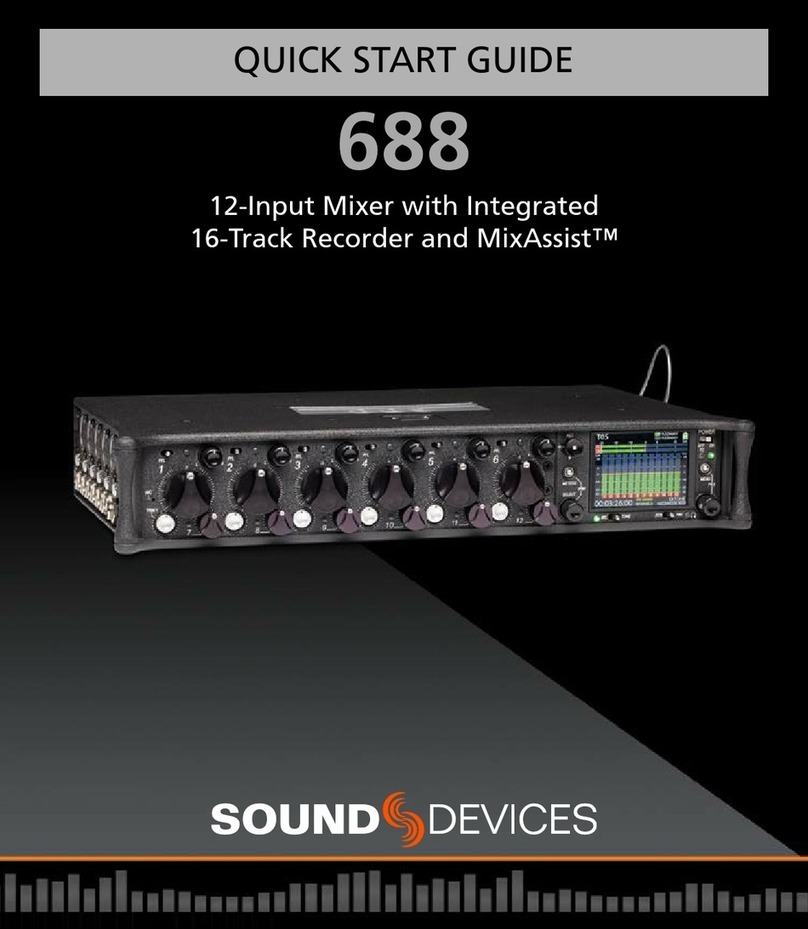
Sound Devices
Sound Devices 688 User manual
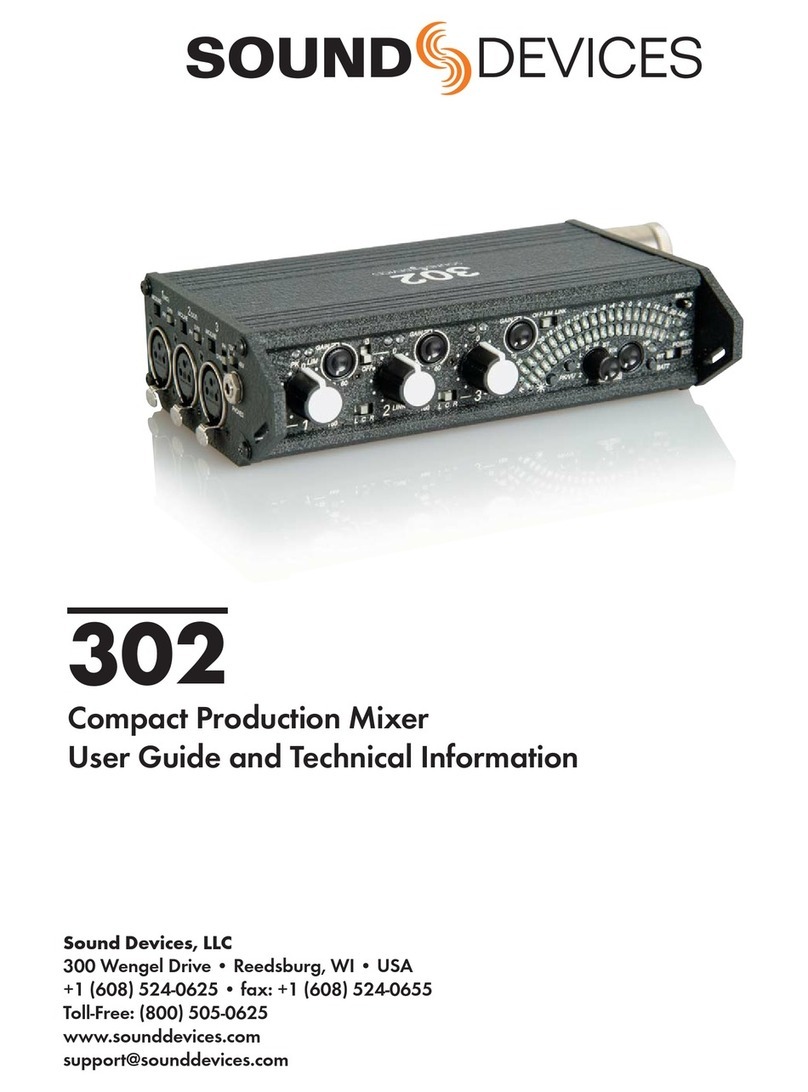
Sound Devices
Sound Devices 302 Manual

Sound Devices
Sound Devices 688 User manual

Sound Devices
Sound Devices MixPre II Series User manual

Sound Devices
Sound Devices 888 User manual
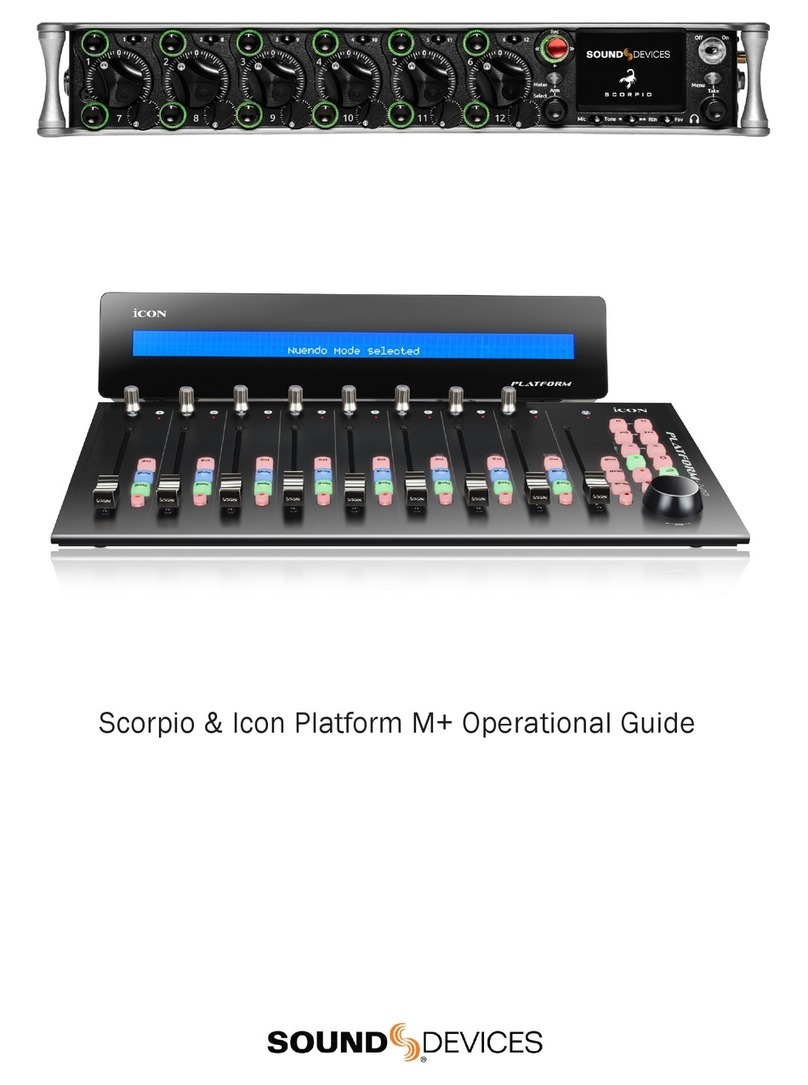
Sound Devices
Sound Devices Scorpio Quick start guide

Sound Devices
Sound Devices 552 Manual
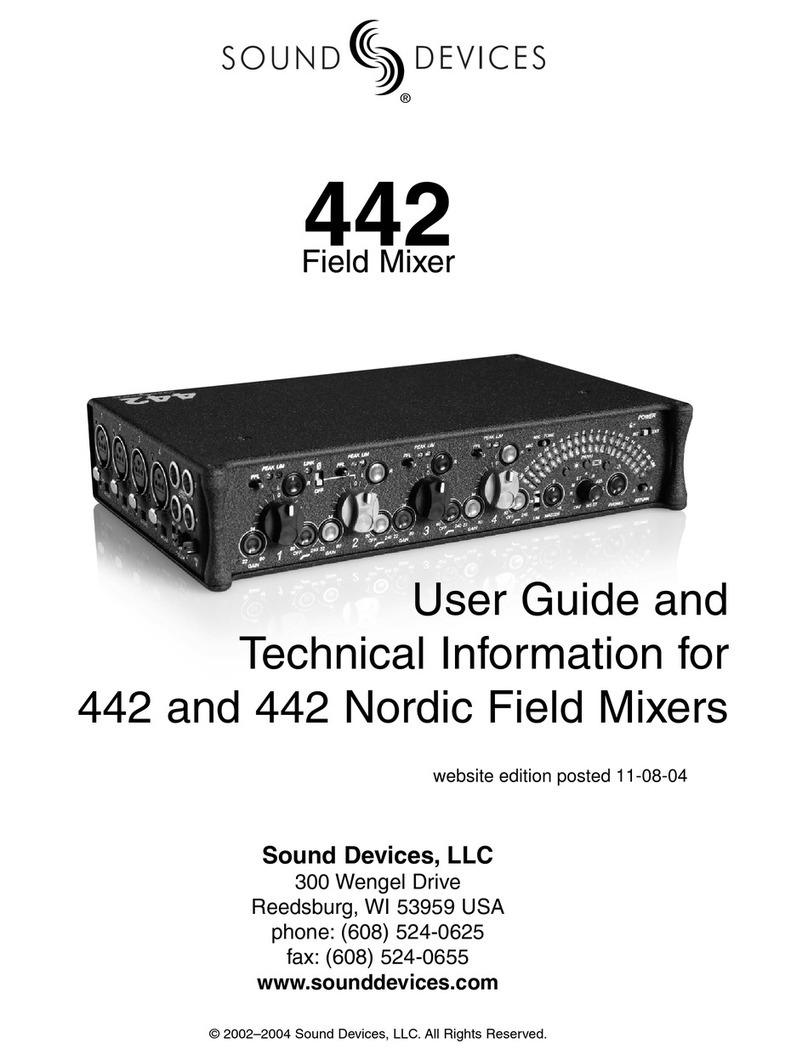
Sound Devices
Sound Devices 442 Manual

Sound Devices
Sound Devices 302 User manual

Sound Devices
Sound Devices 552 Manual

